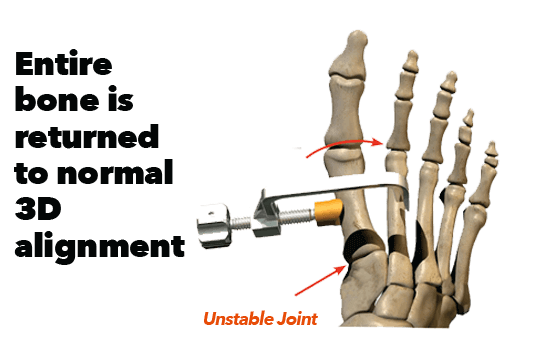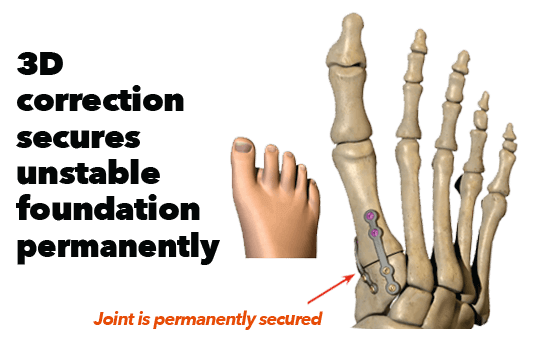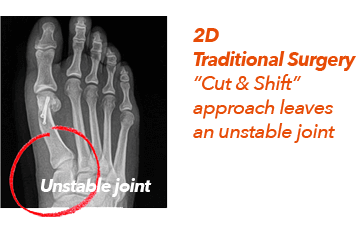
What is a Bunion?
A bunion (Hallux Valgus) is a deformity of the foot that visually manifests as a boney “bump” at the base of the big toe, on the inside of the foot.
What causes the bump is actually a misalignment of the knuckle of the big toe. The knuckle is the joint which connects the first bone of the big toe with the first metatarsal bone of the foot. When this misalignment develops, it causes the metarsal bone to jut out while the big toe leans towards the second toe, rather than pointing straight ahead.
Symptoms and Diagnosis of a Bunion
Aside from the visible deformity, it may be painful to wear shoes, or even to find shoes that fit comfortably over the bump. There may also be pain on the bottom of the foot.
A podiatrist will perform a physical examination and review your health history. X-rays will also be necessary to determine the severity of the bunion and whether arthritis is present.
Treatments for Bunions
There are various treatments available to treat a bunion, which will vary on its severity. The options a podiatrist may suggest can be either conservative (non-surgical) to reduce symptoms or surgical to correct the deformity.
Conservative: A podiatrist may try to minimize symptoms by suggesting changes in footwear—to provide a taller toe box and more comfortable shoes. Custom orthotics may also be used to provide padding or to reposition the big toe. They may also try to modify current footwear by stretching shoes to prevent irritation of the bunion. Toe spacers and bunion sleeves can also provide bunion relief.
Surgical: There are different types of bunion surgery that can be performed to correct the deformity. Realignment surgeries, or osteotomies, return bones and ligaments to their normal positions. Bunionectomies, or exostectomies remove part of the metarsal head to remove the bulge. Fusion surgeries stop the movement bones to reduce pain. Implant surgeries remove the damaged joint with an artificial one.
If you are dealing with a painful condition that you believe might be a bunion, make an appointment with a podiatrist for an examination and to discuss your treatment options.
Lapiplasty® 3D Bunion Correction
Bunions are complex deformities that can be very painful. Elite Podiatry are pleased to offer a new, patented treatment for bunion correction—Lapiplasty® 3D Bunion Correction.
What is Lapiplasty® 3D Bunion Correction?
Lapiplasty® 3D Bunion Correction is an advanced surgical procedure that corrects a bunion by rotating the entire deviated bone back into its normal anatomical position. This is done using specially-designed instrumentation, naturally straightening your toe and removing the “bump” and associated pain. Innovative plating technology is used to permanently secure the unstable joint. Most patients are able to walk within days of surgery. No cast is required; allowing patients to get back to the shoe wear of their choice and activities quickly.


Lapiplasty® Patented Titanium
The Lapiplasty® Procedure utilizes two low-profile (petite), anatomically-shaped titanium plates to permanently secure the unstable foundation of your corrected bunion. This provides buttressing on multiple planes and allows you to walk within days of surgery. Think of this in terms of how a basketball player might hold a basketball. When a player tightly grips the ball with both hands, the ball is held more securely than if only one hand is used.



What Should I Expect In Terms Of Recovery?
The patented titanium plating technology used with the Lapiplasty® Procedure enables patients to bear weight on their foot early. The ability to do so can dramatically improve your recovery process, allowing you to walk up to 6-8 weeks earlier than with the more traditional Lapidus approach (which was previously the only option for addressing the unstable joint).
Being able to walk in a surgical boot, as opposed to being completely non-weight bearing (in a cast with scooter or crutches) for 6-8 weeks, means that you will be getting back to a better quality of life faster; may return to most occupations more quickly; and will be less inconvenienced by bunion surgery.
Frequently Asked Questions
Below are some questions patients commonly ask and their respective answers:
How long does it take to recover from a Lapiplasty® Procedure?
Patients are typically walking within days of surgery. Patients can return to most occupations within days to a couple of weeks, wearing a surgical boot. Within six weeks, you can expect to be walking in comfortable shoes such as tennis shoes, however you should not plan on any high-impact activities for 3-4 months. Short shopping trips and leisurely strolls are examples of the types of activities that should be fine at this point. Around the 4-month mark post-op, you should be able to return to most activities and most shoe wear.
Can I wear fashionable shoes again?
The Lapiplasty® Procedure allows most patients to return to their desired shoes. Of course, some fashionable shoes can be painful (even with a normal foot!), so results can vary from person to person and shoe to shoe.
Can I play sports after the Lapiplasty® Procedure?
Yes, there are no permanent activity limitations after the Lapiplasty® Procedure. Most patients are able to return to most activities after the bones have completely healed at approximately 4 months.
Can the Lapiplasty® Procedure be performed on someone who has previously had traditional surgery?
Yes, the Lapiplasty® Procedure is an option that can be utilized by your doctor when a revision is required. Even if previously treated, patients can experience the same benefits from Lapiplasty® – with a permanently secured foundational joint this time around.
I’ve heard the term “reproducible” used when describing the Lapiplasty® Procedure. What does that mean?
“Reproducible” means that a procedure is easily repeatable with expected results. The Lapiplasty® Procedure utilizes precision, patented instrumentation designed to take the guesswork and “eyeballing” out of bunion surgery; helping ensure your surgeon can get reliable results over and over.
Can the Lapiplasty® Procedure be performed as an outpatient procedure & how long does it last?
Yes, Lapiplasty® surgeries are performed as outpatient procedures. Typically, the surgery will last just under an hour. If your doctor is performing any additional procedures at the same time, the surgery may take longer.
The Lapiplasty Procedure patient education brochure
 Lapiplasty® 3D Bunion Correction Brochure
Lapiplasty® 3D Bunion Correction Brochure

